Stock Market Synchronization: The Role of Geopolitical Risk
Abstract
1. Introduction
2. Data and Methodology
2.1. Data Description
Measures of Geopolitical RISKS
2.2. Methodology and Empirical Model
3. Results and Discussion
3.1. Descriptive Analysis
3.2. Stock Market Synchronization: Application of TVP-VAR
3.3. The Response of Stock Market Synchronization to Geopolitical Risk: Application of Q-Q
4. Conclusions
Author Contributions
Funding
Institutional Review Board Statement
Informed Consent Statement
Data Availability Statement
Conflicts of Interest
References
- Aganbegyan, Ruben Abelovich. 2011. Methodology for Calculating the RTS Index. Available online: https://fs.moex.com (accessed on 27 April 2022).
- Ahlgren, Niklas, and Jan Antell. 2010. Stock market linkages and financial contagion: A cobreaking analysis. Quarterly Review of Economics and Finance 50: 157–66. [Google Scholar] [CrossRef]
- Alqahtani, Abdullah, Elie Bouri, and Xuan Vinh Vo. 2020. Predictability of GCC stock returns: The role of geopolitical risk and crude oil returns. Economic Analysis and Policy 68: 239–49. [Google Scholar] [CrossRef] [PubMed]
- Anatolyev, Stanislav. 2005. A Ten-Year Retrospection of the Behavior of Russian Stock Returns. BOFIT Discussion Papers. No. 9/2005. Helsinki: Bank of Finland, Institute for Economies in Transition (BOFIT). ISBN 952-462-784-1. Available online: https://nbn-resolving.de/urn:NBN:fi:bof-201408072206 (accessed on 27 April 2022).
- Ankudinov, Andrei, Rustam Ibragimov, and Oleg Lebedev. 2017. Sanctions and the Russian stock market. Research in International Business and Finance 40: 150–62. [Google Scholar] [CrossRef]
- Antonakakis, Nikolaos, David Gabauer, Rangan Gupta, and Bill Plakandaras. 2018. Dynamic Connectedness of Uncertainty across Developed Economies: A Time-Varying Approach. Economics Letters 166: 63–75. [Google Scholar] [CrossRef]
- Baker, Scott R, Nicholas Bloom, and Steven J Davis. 2016. Measuring economic policy uncertainty. Quarterly Journal of Economics 131: 1593–636. [Google Scholar] [CrossRef]
- Balcilar, Mehmet, Matteo Bonato, Riza Demirer, and Rangan Gupta. 2018. Geopolitical risks and stock market dynamics of the BRICS. Economic Systems 42: 295–306. [Google Scholar] [CrossRef]
- Beine, Michel, and Bertrand Candelon. 2011. Liberalisation and stock market co-movement between emerging economies. Quantitative Finance 11: 299–312. [Google Scholar] [CrossRef]
- Bloomberg. 2021a. Quotes of the RTS Index. Available online: https://www.bloomberg.com/quote/RTSI$:IND (accessed on 27 April 2022).
- Bloomberg. 2021b. Quotes of the S&P 500 Index. Available online: https://www.bloomberg.com/quote/SPX:IND (accessed on 27 April 2022).
- Bloomberg. 2021c. Quotes of the SSE Index. Available online: https://www.bloomberg.com/quote/SHCOMP:IND (accessed on 27 April 2022).
- Bouri, Elie, Brian Lucey, Tareq Saeed, and Xuan Vinh Vo. 2021. The realized volatility of commodity futures: Interconnectedness and determinants. International Review of Economics & Finance 73: 139–51. [Google Scholar]
- Bouri, Elie, Rangan Gupta, Seyedmehdi Hosseini, and Chi Keung Marco Lau. 2018. Does global fear predict fear in BRICS stock markets? Evidence from a Bayesian Graphical Structural VAR model. Emerging Markets Review 34: 124–42. [Google Scholar] [CrossRef]
- Bouri, Elie, Riza Demirer, Rangan Gupta, and Xiaojin Sun. 2020. The predictability of stock market volatility in emerging economies: Relative roles of local, regional, and global business cycles. Journal of Forecasting 39: 957–65. [Google Scholar] [CrossRef]
- Brock, William, W. Davis Dechert, Jose Scheinkman, and Blake LeBaron. 2001. A test for independence based on the correlation dimension. Growth Theory, Non-Linear Dynamics, and Economic Modelling: Scientific Essays of William Allen Brock 15: 324. [Google Scholar] [CrossRef]
- Caldara, Dario, and Matteo Iacoviello. 2018. Measuring Geopolitical Risk. In International Finance Discussion Paper; Washington, DC: Board of Governors of the Federal Reserve System, vol. 2018. [Google Scholar] [CrossRef]
- Camacho, Maximo, Angela Caro, and German Lopez-Buenache. 2020. The two-speed Europe in business cycle synchronization. Empirical Economics 59: 1069–84. [Google Scholar] [CrossRef]
- Cheng, Chak Hung Jack, and Ching Wai (Jeremy) Chiu. 2018. How important are global geopolitical risks to emerging countries? International Economics 156: 305–25. [Google Scholar] [CrossRef]
- De Nicola, Francesca, Martin Kessler, and Ha Nguyen. 2019. The Financial Costs of the U.S.-China Trade Tensions: Evidence from East Asian Stock Markets. In The Financial Costs of the U.S.-China Trade Tensions: Evidence from East Asian Stock Markets. Washington, DC: World Bank. [Google Scholar] [CrossRef]
- Döpke, Jörg, and Christian Pierdzioch. 2006. Politics and the stock market: Evidence from Germany. European Journal of Political Economy 22: 925–43. [Google Scholar] [CrossRef]
- Égert, Balázs, and Evžen Kočenda. 2011. Time-varying synchronization of European stock markets. Empirical Economics 40: 393–407. [Google Scholar] [CrossRef]
- Eldor, Rafi, and Rafi Melnick. 2004. Financial markets and terrorism. European Journal of Political Economy 20: 367–86. [Google Scholar] [CrossRef]
- Fedorova, Elena, and Kashif Saleem. 2009. Volatility Spillovers between Stock and Currency Markets: Evidence from Emerging Eastern Europe. Paper presented at the 22nd Australasian Finance and Banking Conference, Sydney, Australia, December 14–16. [Google Scholar]
- Goriaev, Alexei, and Alexei Zabotkin. 2006. Risks of investing in the Russian stock market: Lessons of the first decade. Emerging Markets Review 7: 380–97. [Google Scholar] [CrossRef][Green Version]
- Hanus, Luboš, and Lukáš Vácha. 2020. Growth cycle synchronization of the Visegrad Four and the European Union. Empirical Economics 58: 1779–95. [Google Scholar] [CrossRef]
- Hassan, Kamrul, Ariful Hoque, Muammer Wali, and Dominic Gasbarro. 2020. Islamic stocks, conventional stocks, and crude oil: Directional volatility spillover analysis in BRICS. Energy Economics 92: 104985. [Google Scholar] [CrossRef]
- He, Xie, Tetsuya Takiguchi, Tadahiro Nakajima, and Shigeyuki Hamori. 2020. Spillover effects between energies, gold, and stock: The United States versus China. Energy and Environment 31: 1416–47. [Google Scholar] [CrossRef]
- Hoque, Mohammad Enamul, Low Soo Wah, and Mohd Azlan Shah Zaidi. 2019. Oil price shocks, global economic policy uncertainty, geopolitical risk, and stock price in Malaysia: Factor augmented VAR approach. Economic Research-Ekonomska Istrazivanja 32: 3701–33. [Google Scholar] [CrossRef]
- Ji, Qiang, Bing Yue Liu, Wan Li Zhao, and Ying Fan. 2020. Modelling dynamic dependence and risk spillover between all oil price shocks and stock market returns in the BRICS. International Review of Financial Analysis 68: 101238. [Google Scholar] [CrossRef]
- Keppler, Jan Horst. 2007. International Relations and Security of Energy Supply: Risks to Continuity and Geopolitical Risks Foreign Affairs. Brussels: Directorate-General for External Policies of the Union. [Google Scholar]
- Kirkulak Uludag, Berna, and Muzammil Khurshid. 2019. Volatility spillover from the Chinese stock market to E7 and G7 stock markets. Journal of Economic Studies 46: 90–105. [Google Scholar] [CrossRef]
- Kollias, Christos, Efthalia Manou, Stephanos Papadamou, and Apostolos Stagiannis. 2011. Stock markets and terrorist attacks: Comparative evidence from a large and a small capitalization market. European Journal of Political Economy 27 Suppl. 1: S64–S77. [Google Scholar] [CrossRef]
- Lehkonen, Heikki. 2015. Stock Market Integration and the Global Financial Crisis*. Review of Finance 19: 2039–94. [Google Scholar] [CrossRef]
- Liu, Xiao Fan, and Chi K. Tse. 2012. A complex network perspective of world stock markets: Synchronization and volatility. International Journal of Bifurcation and Chaos 22: 1250142. [Google Scholar] [CrossRef]
- Morck, Randall, Bernard Yeung, and Wayne Yu. 2000. The information content of stock markets: Why do emerging markets have synchronous stock price movements? Journal of Financial Economics 58: 215–60. [Google Scholar] [CrossRef]
- Munoz, Beatriz, Javier García-Verdugo, and Enrique San-Martín. 2015. Quantifying the geopolitical dimension of energy risks: A tool for energy modelling and planning. Energy 11: 28040. [Google Scholar] [CrossRef]
- Nivorozhkin, Eugene, and Giorgio Castagneto-Gissey. 2016. Russian stock market in the aftermath of the Ukrainian crisis. Russian Journal of Economics 2: 23–40. [Google Scholar] [CrossRef]
- Saiz, Albert, and Uri Simonsohn. 2013. Proxying for unobservable variables with internet document-frequency. Journal of the European Economic Association 11: 137–65. [Google Scholar] [CrossRef]
- Samargandi, Nahla, Ali M. Kutan, Kazi Sohag, and Faisal Alqahtani. 2020. Equity market and money supply spillovers and economic growth in BRICS economies: A global vector autoregressive approach. North American Journal of Economics and Finance 51: 101060. [Google Scholar] [CrossRef]
- Schmidbauer, Harald, Angi Rösch, Erhan Uluceviz, and Narod Erkol. 2016. The Russian stock market during the Ukrainian crisis: A network perspective. Finance a Uver Czech Journal of Economics and Finance 66: 478–509. [Google Scholar]
- Sim, Nicholas, and Hongtao Zhou. 2015. Oil prices, US stock return, and the dependence between their quantiles. Journal of Banking & Finance 55: 1–8. [Google Scholar] [CrossRef]
- Sohag, Kazi, Anna Gainetdinova, and Oleg Mariev. 2021. The response of exchange rates to economic policy uncertainty: Evidence from Russia. Borsa Istanbul Review. [Google Scholar] [CrossRef]
- Tiwari, Aviral Kumar, Samia Nasreen, Subhan Ullah, and Muhammad Shahbaz. 2021. Analysing spillover between returns and volatility series of oil across major stock markets. International Journal of Finance and Economics 26: 2458–90. [Google Scholar] [CrossRef]
- Wälti, Sébastien. 2011. Stock market synchronization and monetary integration. Journal of International Money and Finance 30: 96–110. [Google Scholar] [CrossRef]
- Xu, Haifeng, and Shigeyuki Hamori. 2012. Dynamic linkages of stock prices between the BRICs and the United States: Effects of the 2008–09 financial crisis. Journal of Asian Economics 23: 344–52. [Google Scholar] [CrossRef]
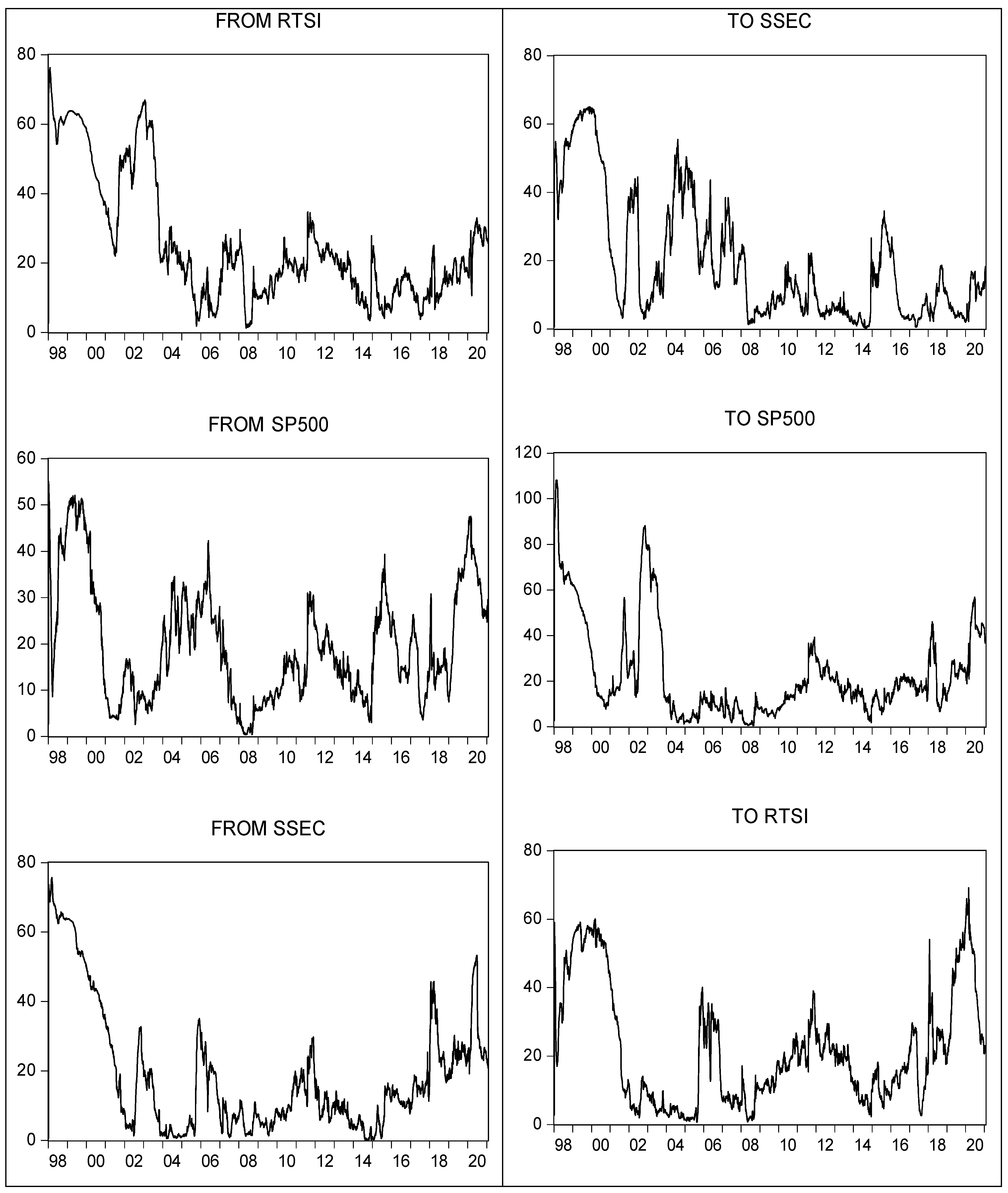

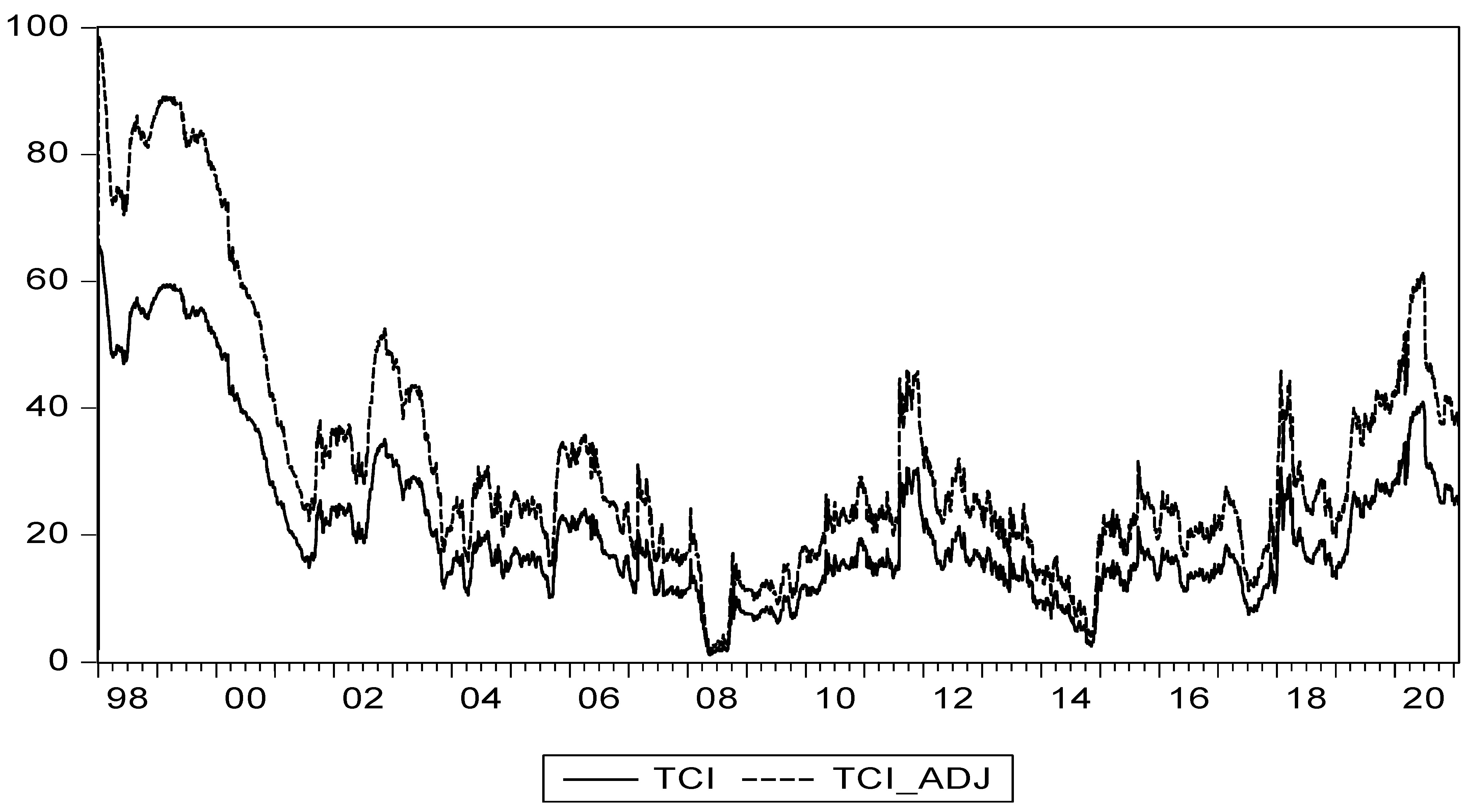
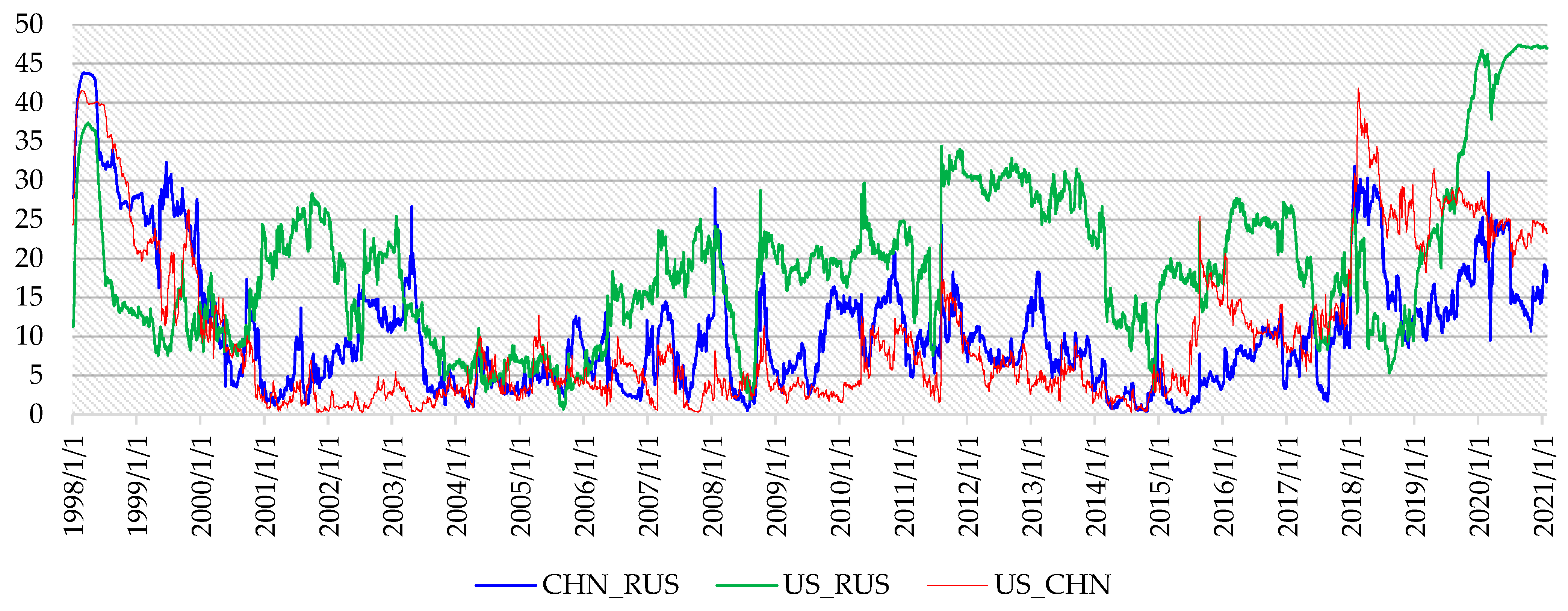
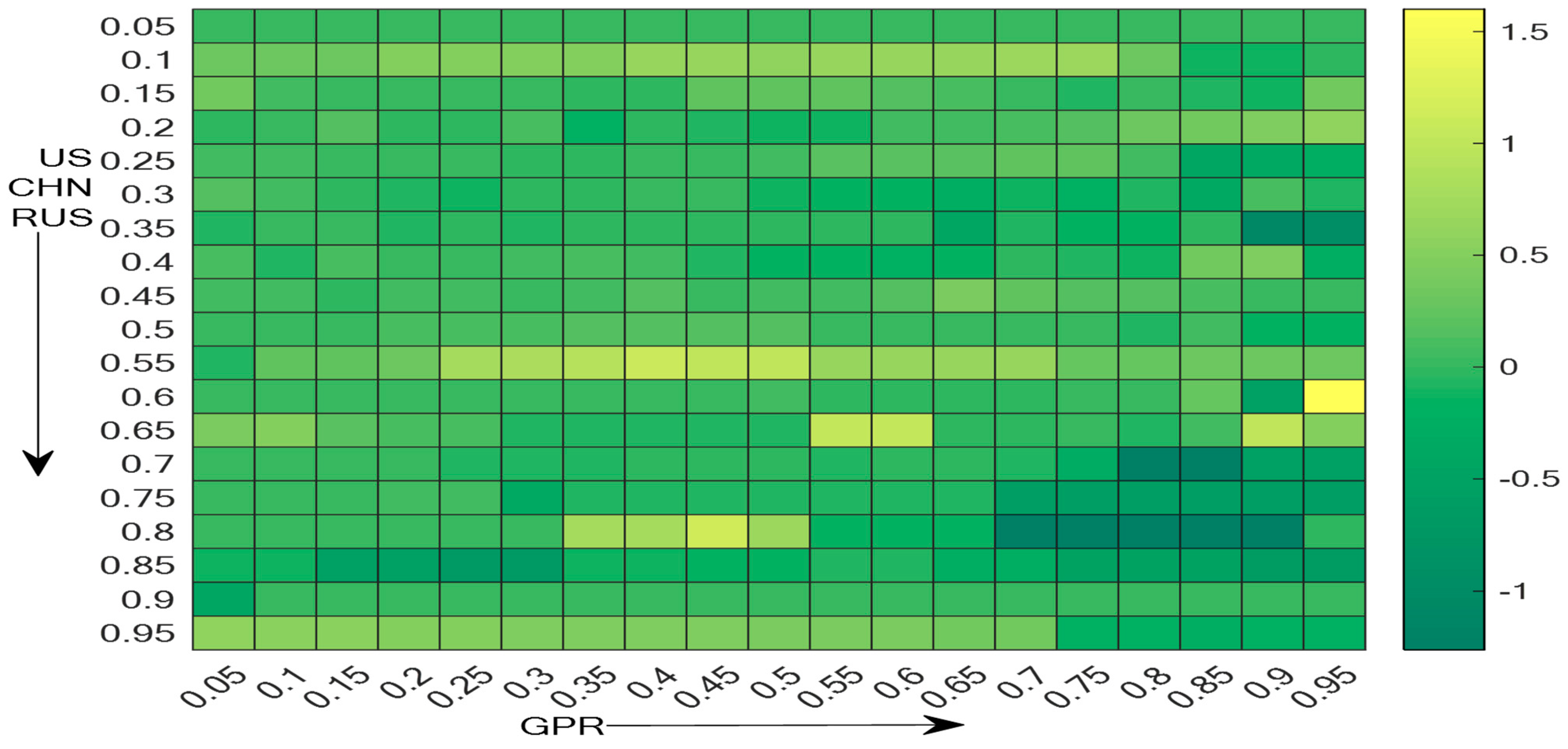

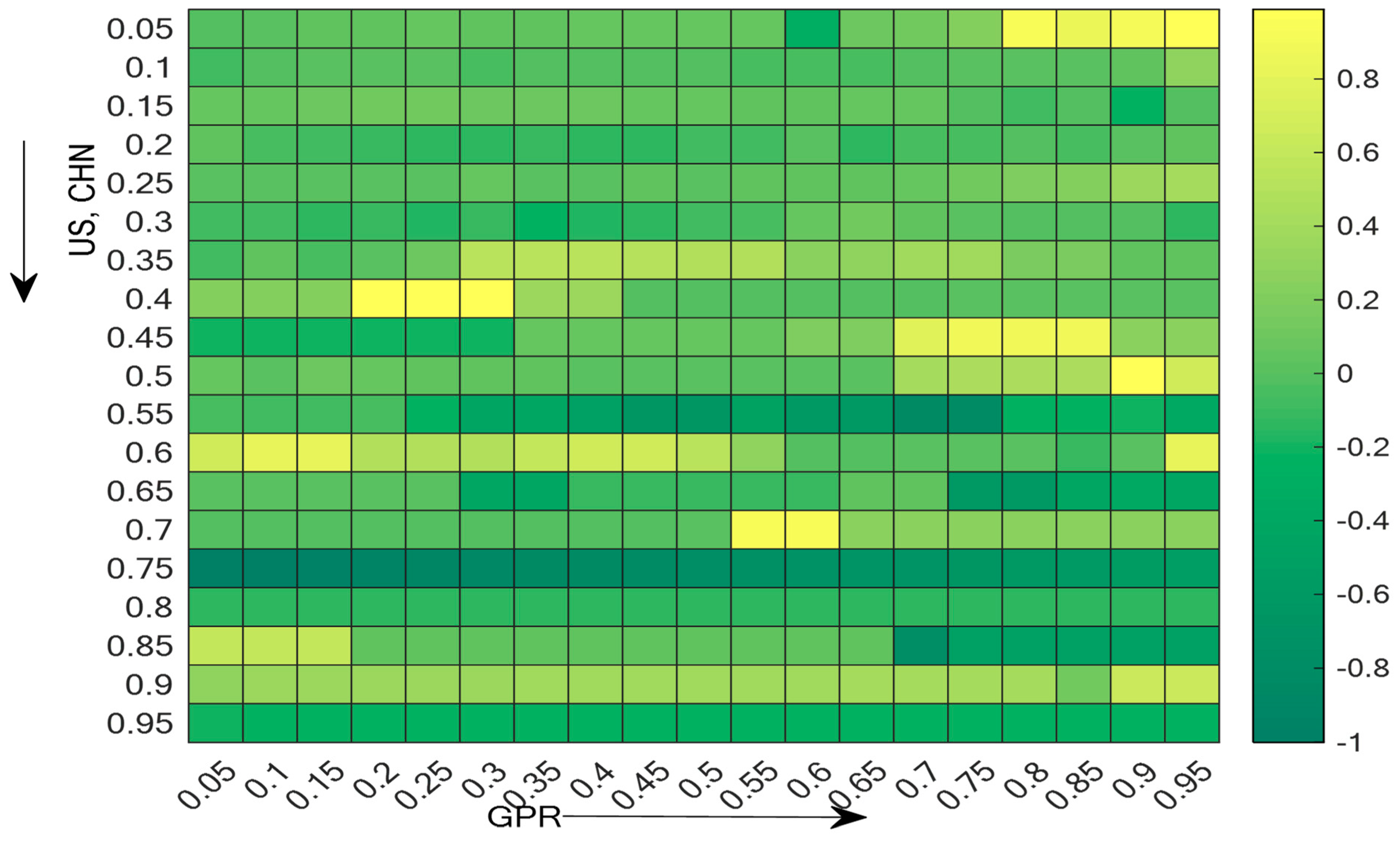

| Variable | Description | Source |
|---|---|---|
| RTSI | Russian Federation stock index | (Bloomberg 2021a) |
| S&P 500 | United States stock index | (Bloomberg 2021b) |
| SSE | China stock index | (Bloomberg 2021c) |
| GPR | It is a monthly indicator calculated based on a tally of newspaper articles covering geopolitical tensions. | Caldara and Iacoviello (2018) |
| CH_RUS | GPR | RTSI | SP500 | SSEC | US_CH | US_CH_RUS | US_RUS | |
|---|---|---|---|---|---|---|---|---|
| Mean | 10.90237 | 4.674304 | 1006.146 | 1622.027 | 2388.949 | 10.27873 | 26.15838 | 19.07512 |
| Median | 8.844000 | 3.696022 | 1084.475 | 1353.165 | 2276.370 | 6.190000 | 23.66650 | 18.27350 |
| Maximum | 43.84100 | 28.18862 | 2487.920 | 3855.360 | 6092.060 | 41.81300 | 58.13100 | 47.38900 |
| Minimum | 0.229000 | 3.694868 | 38.53000 | 676.5300 | 1011.500 | 0.240000 | 4.859000 | 0.656000 |
| Std. Dev. | 8.409256 | 3.279826 | 577.7113 | 668.9518 | 902.7215 | 9.907989 | 12.06162 | 9.945539 |
| Skewness | 1.429054 | 2.882043 | 0.049084 | 1.185738 | 0.776080 | 1.307407 | 0.797993 | 0.807721 |
| Kurtosis | 5.153327 | 16.05406 | 2.144023 | 3.486554 | 3.822718 | 3.798447 | 2.961621 | 3.635217 |
| Jarque–Bera | 3213.137 | 51,094.97 | 186.2639 | 1470.532 | 774.3458 | 1875.543 | 639.4971 | 756.0499 |
| Probability | 0.000000 | 0.000000 | 0.000000 | 0.000000 | 0.000000 | 0.000000 | 0.000000 | 0.000000 |
| Sum | 65,654.08 | 28,148.66 | 6,059,009 | 9,767,848 | 14,386,249 | 61,898.51 | 157,525.8 | 114,870.4 |
| Sum Sq. Dev. | 425,778.5 | 64,769.47 | 2.01 × 109 | 2.69 × 109 | 4.91 × 109 | 591,071.0 | 875,950.9 | 595,559.6 |
| Observations | 6022 | 6022 | 6022 | 6022 | 6022 | 6022 | 6022 | 6022 |
| BDS test | ||||||||
| Dimension | 2 | 2 | 2 | 2 | 2 | 2 | 2 | 2 |
| BDS statistics | 0.197 *** | 0.201 *** | 0.203 *** | 0.205 *** | 0.202 *** | 0.203 *** | 0.199 *** | 0.199 *** |
| z-statistics | 158.771 | 153.351 | 327.747 | 187.839 | 244.887 | 165.559 | 207.269 | 200.536 |
| SP500 | SSEC | RTSI | FROM | |
|---|---|---|---|---|
| SP500 | 77.153 | 10.170 | 12.677 | 22.847 |
| SSEC | 13.117 | 76.578 | 10.305 | 23.422 |
| RTSI | 24.188 | 8.018 | 67.794 | 32.206 |
| Contribution to others | 37.305 | 18.188 | 22.982 | 78.475 |
| Contribution including own | 114.458 | 94.766 | 90.776 | TCI |
| Net Spillovers | 14.458 | −5.234 | −9.224 | 26.158 |
Publisher’s Note: MDPI stays neutral with regard to jurisdictional claims in published maps and institutional affiliations. |
© 2022 by the authors. Licensee MDPI, Basel, Switzerland. This article is an open access article distributed under the terms and conditions of the Creative Commons Attribution (CC BY) license (https://creativecommons.org/licenses/by/4.0/).
Share and Cite
Sohag, K.; Vasilyeva, R.; Urazbaeva, A.; Voytenkov, V. Stock Market Synchronization: The Role of Geopolitical Risk. J. Risk Financial Manag. 2022, 15, 204. https://doi.org/10.3390/jrfm15050204
Sohag K, Vasilyeva R, Urazbaeva A, Voytenkov V. Stock Market Synchronization: The Role of Geopolitical Risk. Journal of Risk and Financial Management. 2022; 15(5):204. https://doi.org/10.3390/jrfm15050204
Chicago/Turabian StyleSohag, Kazi, Rogneda Vasilyeva, Alina Urazbaeva, and Valentin Voytenkov. 2022. "Stock Market Synchronization: The Role of Geopolitical Risk" Journal of Risk and Financial Management 15, no. 5: 204. https://doi.org/10.3390/jrfm15050204
APA StyleSohag, K., Vasilyeva, R., Urazbaeva, A., & Voytenkov, V. (2022). Stock Market Synchronization: The Role of Geopolitical Risk. Journal of Risk and Financial Management, 15(5), 204. https://doi.org/10.3390/jrfm15050204






